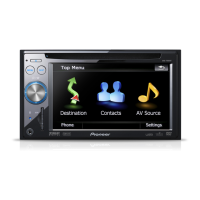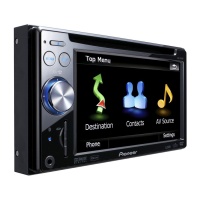



Do you have a question about the Pioneer AVIC-F980DAB and is the answer not in the manual?
Details on the product's internal memory and data subject to erasure.
Information on data erasure when the vehicle battery is disconnected.
Procedure to reset the system's microprocessor to factory default settings.
Guidance on manual usage and potential screen variations.
Identification and explanation of the product's physical parts and their functions.
Step-by-step instructions for safely removing the detachable faceplate.
Precautions for LCD use, angle adjustment, and media insertion/ejection.
Procedures for inserting and ejecting discs.
Procedures for inserting and ejecting SD memory cards.
Steps for plugging and unplugging USB storage devices.
The initial setup process for the navigation system after installation.
Overview of main application, navigation, AV, and phone screens.
Accessing system settings, time/date, and AV source selection.
List of audio-visual sources compatible with the system.
Displaying the AV operation screen, selecting sources, and managing their order.
Guidelines for operating the system using the touch screen.
Explanation of standard touch keys, list navigation, and time bar controls.
Using the navigation menu to search destinations and view traffic.
Accessing various navigation features like map views, favourites, and settings.
Controls for managing planned routes, waypoints, and detours.
Understanding map elements, AV info bar, and Smart Zoom feature.
Switching map views (2D/3D) and manually adjusting map scale.
Scrolling the map and using control keys for navigation.
Understanding route guidance, common events, and lane information.
Displaying signposts, junction view, data fields, and route planning.
Overview of planning a route by searching for destinations.
Steps to search for a destination using its street address.
Finding POIs via preset categories or by name/category.
Locating nearby emergency and roadside assistance services.
Routing to saved locations, routes, recent searches, and Smart History.
Finding locations by combined search criteria or coordinates.
Selecting destinations via map scrolling and using Map Location screen options.
Building routes with Route Planner and changing the starting position.
Checking route alternatives, adding waypoints, and restoring original routes.
Checking detours, route preferences, and cancelling guidance.
Running a simulation of the current route as a demonstration.
Saving home/work locations, favourite places, and editing stored locations.
Saving favourite routes and editing stored routes.
Marking locations for alerts and editing stored alert points.
Accessing and viewing traffic summaries and event lists.
Visualizing traffic events on the map and understanding their impact.
Turning traffic info on/off and accessing useful trip information.
Activating, browsing, setting, and editing trip logs.
Displaying and managing trip data in the Trip Computer.
Calculating fuel consumption and setting reminders.
Overview of settings for route preferences, sound, warnings, and map display.
Configuring vehicle type, road types, and route planning methods.
Settings for navigation mode, motorways, tolls, and ferries.
Configuring voice guidance, street announcements, and verbosity.
Configuring speed warnings, alert points, and road sign warnings.
Adjusting map display, viewpoint, colour modes, landmarks, buildings, and terrain.
Settings for route progress, detours, services, and congestion offers.
Configuring language, voice, and units of measurement.
Adjusting menu animations, daytime/nighttime themes, and display options.
Configuring traffic information and enabling online features.
Configuring alerts for categories like speed cameras and points of interest.
Configuring speed warnings, alert points, and road sign warnings.
Getting map updates and understanding AVICSYNC features and compatibility.
Checking AVICSYNC compatibility and preparing for its use.
Displaying the Bluetooth screen and registering Bluetooth devices.
Managing auto-connection, deleting devices, and adjusting visibility.
Setting PIN codes, clearing memory, and updating Bluetooth software.
Accessing phone menu, making calls, and managing call history.
Using preset dial lists and deleting phone numbers.
Adjusting dial confirmation, auto-answer, ring tone, private mode, and volume.
Using voice recognition and general notes on hands-free phoning.
Overview of setup steps and connection methods for smart devices.
Lists of compatible iPod/iPhone and Android devices.
Information on connections and functions for iPod/iPhone devices.
Connection methods and available sources for Android devices.
Using preset channels, bands, manual/seek tuning, and storing stations.
Adjusting tuning sensitivity, FM step, and sound quality.
Adjusting FM sound quality, frequency search, Auto PI, regional limits, and traffic/news interrupts.
Using preset channels, bands, manual/seek tuning, and storing services.
Adjusting soft link, traffic announcements, aerial power, and service follow.
Listening to time-shifted broadcasts and selecting service components.
Configuring soft link, traffic announcements, and receiving TA.
Interface for playing audio discs, including random and repeat modes.
Managing playback, angle selection, bookmarks, audio output, and repeat modes.
Controlling subtitle/audio language, DVD menus, file types, and searching.
Interface for playing audio/video files from USB/Disc, including playback controls.
Managing still image rotation, folder navigation, and video playback controls.
Switching media file types and selecting subtitle/audio languages.
Starting playback from discs, USB/SD, and common file operations.
Browsing audio files and selecting songs via link search.
Setting slideshow intervals and managing iPod audio playback features.
Managing iPod playback, Apple Music Radio, and track skipping.
Connecting an iPod, starting its functions, and selecting playlist content.
Managing song similarity, wish lists, and playback settings.
Navigating AppRadio Mode screens and checking device compatibility.
Using AppRadio Mode with Android devices and iPhone keyboard.
Adjusting image size and using the audio mix function.
Using Apple CarPlay for iPhone control and initiating the connection.
Adjusting guidance and alert sound volumes for Apple CarPlay.
Using Android Auto for smartphone control and initiating the connection.
Setting driving position, auto-launch, and volume adjustments.
Interface for audio playback, including skip, random, pause, and file selection.
Starting the Bluetooth audio player and selecting files from lists.
Using HDMI input and configuring video signal settings.
Using AUX input and configuring video signal settings.
Starting procedures for camera/AV sources and video signal settings.
Navigating MIXTRAX, BPM setting, playback portion, and visual display.
Starting MIXTRAX, selecting items, and choosing songs to exclude.
Accessing MIXTRAX settings and configuring flash patterns.
Displaying rear camera, parking assist, climate control, and seat settings.
Connecting the Vehicle Bus adapter for vehicle status display.
Showing obstacle detection and climate control panel status.
Accessing system settings, navigation info, Bluetooth, beep tone, and rear camera.
Configuring rear camera, polarity, image reversal, and parking guidelines.
Setting up and activating the second camera input.
Configuring reversed image, camera view, safe mode, and language settings.
Calibrating touch panel response and selecting system language.
Configuring dimmer settings and adjusting display picture parameters.
Updating firmware and viewing version and license information.
Checking sensor status, clearing data, and verifying lead connections.
Setting rear camera, parking assist guidelines, and second camera.
Adjusting fader/balance, sound muting, source levels, and cutoff frequencies.
Configuring rear speaker output and subwoofer settings.
Adjusting speaker output levels and time alignment for sound.
Using preset/custom equalizers and performing Auto EQ.
Performing Auto EQ and adjusting the automatic sound levelizer.
Selecting wallpaper, illumination colour, and theme colours.
Changing clock styles and the preinstalled splash screen.
Managing splash screens and replicating theme settings.
Configuring video player, languages, and angle icon display.
Adjusting aspect ratio, parental lock, DivX codes, and DVD auto playback.
Configuring rear camera video signal and display.
Switching video output format between PAL and NTSC.
Creating, selecting, and removing shortcuts in the favourite menu.
Configuring time/date settings and the Sound Retriever function.
Tagging iPod songs and selecting video output for the rear display.
Setting up the anti-theft function and product password.
Deleting passwords and restoring factory default settings.
Resolving common problems with the system, AV screen, and video output.
Resolving audio, operation, picture, parental lock, and iPod issues.
Understanding and responding to system error messages.
Resolving issues with GPS, calibration, sensors, speed pulse, and DAB tuner.
Troubleshooting disc errors, unsupported formats, and external storage issues.
Resolving issues with USB devices, iPods, and Apple CarPlay connections.
Troubleshooting Bluetooth module errors and iPod tagging issues.
Resolving Android Auto connection and Bluetooth pairing issues.
How GPS, dead reckoning, and map matching ensure accurate positioning.
Handling large errors, GPS impossibility, and conditions causing positioning errors.
Illustrations of various driving scenarios that can cause positioning errors.
Illustrations of driving situations that can cause positioning errors.
Understanding how routes are calculated and potential limitations.
Understanding route highlighting on the map and the auto reroute function.
Precautions for disc handling, playable formats, and compatibility.
General notes regarding disc compatibility and common issues.
Compatibility notes for DVD-Video, DVD-R/RW, and CD-R/RW discs.
General notes for USB/SD devices and DivX files.
Compatibility details for MP3, WMA, WAV, AAC, FLAC, and DivX files.
Detailed specifications for various video file formats like MP4, 3GP, MKV.
Information on DivX certification, AAC technology, and Google trademarks.
Information on protecting iPod data and avoiding environmental damage.
Details on service requirements, data plans, and content limitations.
Trademarks and notices for HDMI, MHL, and IVONA technologies.
Notices regarding video viewing, MP3 usage, and open source licenses.
Proper handling, care, and understanding of LCD screen properties.
Cleaning and maintaining the LCD screen and information on LED backlight.
Overview of general, display, and audio technical specifications.
Specifications for JPEG, SD card, Bluetooth, and tuner compatibility.
| Widescreen | - |
|---|---|
| Display diagonal | 6.2 \ |
| Display resolution | - pixels |
| Languages support | Multi |
| Number of points of interest | 10000000 |
| Speaker power | 200 W |
| Hands-free calling | Keep your hands on wheel with Bluetooth™ Hands-free calling. After pairing your compatible Bluetooth mobile phone to your TomTom GPS, you’ll be able to see incoming call information, make and answer calls, and talk hands-free through your device. You’ll e |
| Audio formats supported | AAC, FLAC, MP3, WAV, WMA |
| Image formats supported | JPEG |
| Video formats supported | DIVX, FLV, H.264, MKV, MPEG1, MPEG2, MPEG4, WMV |
| Equalizer bands quantity | 13 |
| Supported radio bands | AM, DAB+, FM |
| Preset stations quantity | 24 |
| DIN size | 2 DIN |
| Product color | Black |
| Map storage | Memory card |
| Lifetime map updates | Roads change, but with Lifetime Map Updates your map will always be up to date. Start fresh every few months by downloading a new edition of the industry's most accurate map. New editions are issued four times per year. |
| Marine (chartplotters, sounders) | No |
| Storage media type | Flash |
| Width | - mm |
|---|---|
| Weight | - g |












